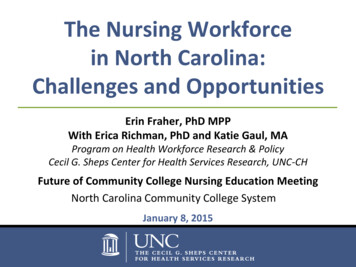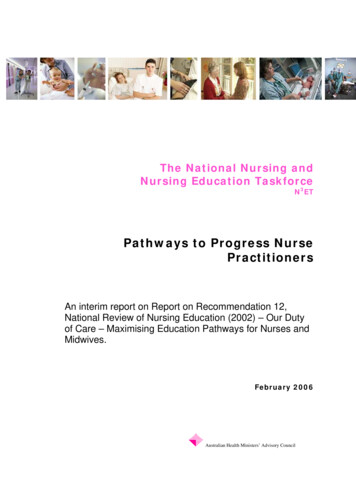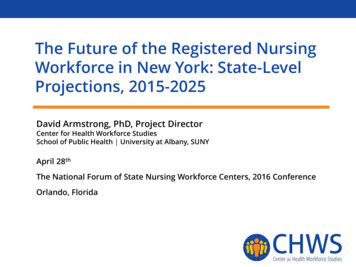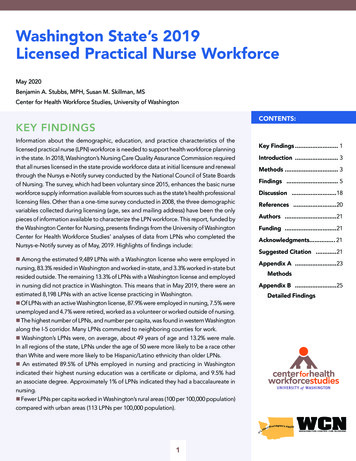
Transcription
The Nursing Workforcein North Carolina:Challenges and OpportunitiesErin Fraher, PhD MPPWith Erica Richman, PhD and Katie Gaul, MAProgram on Health Workforce Research & PolicyCecil G. Sheps Center for Health Services Research, UNC-CHFuture of Community College Nursing Education MeetingNorth Carolina Community College SystemJanuary 8, 2015
Presentation OverviewPart 1 The NC Health Professions Data System:who are we and why should you trust our data? Do we (will we) have a nursing shortage in North Carolina? The current nursing workforce—how do ADN nurses differ from nurseswith a baccalaureate degree or higher?LUNCHPart 2 The future nursing workforce in a transformed health system What can we do now to prepare for the future nursing workforce?
In case your office calls,here’s the presentation in one slide The nursing workforce is critical to transforming ourhealth care system The practice and geographic characteristics of ADN nursesdiffer significantly from nurses with a baccalaureate degreeor higher. We need to be aware of these differences as weplan for the future. Health system transformation is going to have profoundeffect on the nursing workforce We need to retool:– the existing workforce– our education, regulatory and payment systems
Who we are: The North CarolinaHealth Professions Data System (HPDS)Mission: to provide timely, objective data and analysis toinform health workforce policy in North Carolina and theUnited States Based at Cecil G. Sheps Center for Health ServicesResearch at UNC-CH, but mission is statewide Collaboration between Sheps Center, the healthprofessions licensing boards and the NC AHEC Our data and analyses are independent of governmentand health care professionals Independence brings rigor and objectivity
NC’s health workforce data are theenvy of the other 49 states Over 30 years of continuous, complete licensure(not survey) data on 19 health professions from12 boards Data are provided voluntarily by the boards—there is no legislation that requires this, thereis no appropriation Data housed at Sheps but remain property of licensingboard, permission sought for each “new” useSystem would not exist without dataand support of licensure boards
All good academics declare theirhypotheses up front. Here’s mine:The nursing workforce is pivotal tohealth system transformation
Why the nursing workforce is criticalto health system transformation With over 97,000 nurses in active practice, nursing is by farlargest licensed health profession (4x as many nurses asphysicians) Nursing care related to key quality and satisfaction measuresthat will increasingly be tied to value-based payments Nurses provide holistic care across health and communitybased settings Generalist education make nurses the perfect “stem cell”providers to take on new roles and new functions intransformed health system
But will we have enoughnurses in the future?
I believe we have, and will have,enough nurses in the future A “shortage narrative” exists—based on belief that growing,aging population with increasing chronic disease andexpanded health insurance coverage will demand morecare than can be provided by workforce Federal nursing projections produced by the Health Resourcesand Services Administration (HRSA) last month suggest:– an oversupply of nurses nationally– a shortage of 12,900 nurses in North Carolina I’m not convinced. Are you? Let’s unpack the projections
Federal projections use American CommunitySurvey (ACS) data. We have better dataStarting supply –HRSA model shows 95,800 nurses in 2012 in NCLicensure data show 97,222 in active practice in the state in2012 HRSA model underestimates baseline supply by 1,422 nursesProjecting Future Growth –HRSA model estimates average annual supply growth rate of0.9%.Licensure data show for past 10 years, average growth rate hasbeen between 1.8-3.5%
How did HRSA estimateannual growth rate? HRSA model used first time takers of NCLEX in 2012 asproxy for new entrants. Holds new entrants constant at3,837 out to 2025 According to licensure data, there were4,013 new entrants to workforce in 2012 NC is one of fastest growing states in country.HRSA model did not allow for migration. HRSA model likely underestimates annual supply growth
Models are sensitive to assumptionsabout nurses’ behaviorHRSA model assumes: Increasing probability of retirement between 50-75, all nurses retire at 75 Supply demand in 2012, yet many would argue NC was already in state ofover supply in 2012.Why are these assumptions important? Before equilibrium assumption, HRSA model showed NC demand fornurses in 2012 was 89,200 and available supply was 95,800 This is an oversupply of 6,600 nurses (7% of total workforce ) atbaseline that would have carried forward in model No adjustment for generational effects yet we know nurses in morerecent generations are retiring later (Auerbach et al 2014). Later retirements mean larger workforce supply
The other side of the modeling equation the HRSA demand side model On the demand side, national health care use anddelivery patterns were applied to North Carolina Model converts demand for services (e.g., visits) into demandfor providers (e.g., FTEs) using staffing ratios Model assumes staffing ratios will remain constant to 2025 Model doesn’t account for new models of care and the shift ofcare (and the workforce!) to outpatient settings
% of NC Hospitals Reducing Payroll ExpensesMost Hospitals Are Reducing PayrollTrend across Jan-Mar Quarters62%33%32%29%36%32%26%21%9%2006% Hospitals20072008200920102011201220132014Source: NCHA ANDI, June 2014Percent of hospitals with declining payroll compared with Jan-Mar quarter of previous year. Excludes contract labor. Expenses notadjusted for inflation.Cutting Payroll ExpensesSlide courtesy of Sarah Broome, NCHA.
Modeling is complicated.Key takeaways Thanks to the NC Board of Nursing, we have betterdata than the feds We do not face a nursing shortage now, nor are welikely to face one in the future Focusing on whether we have a nursing shortagedistracts us from a more important question:Will we have the right mix of nurses in theright locations, specialties and practice settingswith the skills and competencies needed to meetNC’s population health needs?
The current workforce inNorth Carolina: how doADN nurses differ from nurseswith a baccalaureate or higher?
Highest Degree of North CarolinaNursing Workforce: 1982-2012North Carolina Nursing Workforce by Highest Degree, 1982-2012Note: Data include RNs who were actively practicing in North Carolina as of October 31 of the respective year. Source: North Carolina Health Professions Data System, with dataderived from the NC Board of Nursing, 2012. Produced by: Program on Health Workforce Research and Policy, Cecil G. Sheps Center for Health Services Research, UNC-CH.
Asians, African Americans more likelyto have baccalaureate or higherNorth Carolina Nursing Workforce by Race/Ethnicity and Highest Degree, 20%10%0%Native Am.WhiteHispanicADNOtherAfrican Amer.AsianBacc or higherNote: Data include RNs who were actively practicing in North Carolina as of October 31, 2012. Source: North Carolina Health Professions Data System, with dataderived from the NC Board of Nursing, 2012. Produced by: Program on Health Workforce Research and Policy, Cecil G. Sheps Center for Health Services Research, UNC-CH.Total
Male nurses more likely to have BSNNorth Carolina Nursing Workforce by Race/Ethnicity and Highest Degree, 2012100%90%80%38%70%60%50%40%30%The averageage of ADN andbaccalaureateor higher nursesis the same at44 years of age.62%43%57%20%10%0%MaleFemaleBacc or higherADNNote: Data include RNs who were actively practicing in North Carolina as of October 31, 2012. Source: North Carolina Health Professions Data System, with dataderived from the NC Board of Nursing, 2012. Produced by: Program on Health Workforce Research and Policy, Cecil G. Sheps Center for Health Services Research, UNC-CH.
Most nurses work in hospitals butADN nurses more likely to work in homecare/hospice and long-term careNorth Carolina Nursing Workforce byEmployment Setting and Highest Degree, 2012sch of nursing/medicine0.4%3.5%1.5%2.4%mental health fac3.5%2.7%public clinic/health dept5.2%home care/hospice10.1%1.2%0.9%HMO/insurance co7.0%6.0%solo/group med pract3.4%long term care8.6%9.7%9.2%hosp out-patient53.7%50.7%hosp in-patient0%10%20%Bacc or higher30%40%ADNNote: Data include RNs who were actively practicing in North Carolina as of October 31, 2012. Source: North Carolina Health Professions Data System, with dataderived from the NC Board of Nursing, 2012. Produced by: Program on Health Workforce Research and Policy, Cecil G. Sheps Center for Health Services Research, UNC-CH.50%60%
Similar distributions byclinical practice area but ADN nursesmore likely to work in geriatricsNorth Carolina Nursing Workforce byClinical Practice Area and Highest Degree, 20121.4%1.9%rehab13.7%14.1%crit/emerg care3.7%4.1%psych mental ommu/occup he7.0%6.8%0%5%10%Bacc or higher15%20%25%ADNNote: Data include RNs who were actively practicing in North Carolina as of October 31, 2012. Source: North Carolina Health Professions Data System, with dataderived from the NC Board of Nursing, 2012. Produced by: Program on Health Workforce Research and Policy, Cecil G. Sheps Center for Health Services Research, UNC-CH.30%35%
ADN nurses twice as likelyto work in rural countiesNorth Carolina Nursing Workforce by Rural Status and Highest Degree, 12.3%0%Bacc or higherADNsruralurbanRural source: US Census Bureau and Office of Management and Budget, March 2013. ”Core Based Statistical Area” (CBSA) is the OMB’s collectiveterm for Metropolitan and Micropolitan Statistical areas. Here, nonmetropolitan counties include micropolitan and counties outside of CBSAs.Note: Data include RNs who were actively practicing in North Carolina as of October 31, 2012. Source: North Carolina Health Professions Data System, with dataderived from the NC Board of Nursing, 2012. Produced by: Program on Health Workforce Research and Policy, Cecil G. Sheps Center for Health Services Research, UNC-CH.
ADNs are better distributed across statewhile baccalaureate and higher clustermore around hospitalsDistribution of ADNs and Baccalaureate or Higher RNsActively Practicing in North Carolina in 2012Rural source: US Census Bureau and Office of Management and Budget, March 2013. ”Core Based Statistical Area” (CBSA) is the OMB’s collectiveterm for Metropolitan and Micropolitan Statistical areas. Here, nonmetropolitan counties include micropolitan and counties outside of CBSAs.
ADN nurses significantly more likely to work inmost economically distressed (Tier 1) countiesNorth Carolina Nursing Workforce by Economic Tier and Highest Degree, 201264%Tier 3 (Least Distressed) n 51,02836%49%Tier 2 n 21,02851%44%Tier 1 (Most Distressed) n 9,46362%0%10%20%30%Bacc or Higher40%50%ADNsSource for economic tiers: centive-reports/county-tier-designations. Retrieved 5/12/14.Note: Data include RNs who were actively practicing in North Carolina as of October 31, 2012. Source: North Carolina Health Professions Data System, with dataderived from the NC Board of Nursing, 2012. Produced by: Program on Health Workforce Research and Policy, Cecil G. Sheps Center for Health Services Research, UNC-CH.60%70%
Do nurses who entered theworkforce with an ADN but have abaccalaureate or higher degreebehave more like ADNs orbaccalaureate nurses?
Number of nurses with ADN at entry withhighest degree at baccalaureate or higherhas increased dramaticallyNumbers of North Carolina Nurses Entering with ADN as EntryDegree Who Have Baccalaureate or Higher Degree, 1982-20128,0007,1027,000Bacc nursing6,000Bacc other5,000Masters nursing4,000Masters 006772072,3449400198219871992199720022007Note: Data include RNs who were actively practicing in North Carolina as of October 31, 2012. Source: North Carolina Health Professions Data System, with dataderived from the NC Board of Nursing, 2012. Produced by: Program on Health Workforce Research and Policy, Cecil G. Sheps Center for Health Services Research, UNC-CH.2012
Evidence of education mobilityor career mobility? In 2012, 14,300 nurses in the NC workforce had an ADN forentry degree but had baccalaureate as highest degree This group is of interest—to understand whether these nursesbehave more like ADN nurses or like nurses withbaccalaureate The data do not allow us to distinguish between nurses whoentered the profession with an ADN:– and pursued additional education (the “education mobility” group)– after obtaining a baccalaureate or higher in another field(the “career mobility” group) For purpose of analysis, we call them “mobility nurses”
Settings and Practice Areas: Do Mobility Nurses LookMore like ADNs or Baccalaureate Nurses?Settings of Mobility Nurses Mobility nurses look more like baccalaureate nurses Mobility nurses less likely to work in long-term care and homehealth than ADNs who did not pursue additional educationPractice Areas of Mobility Nurses Mobility nurses less likely than ADN nurses to practice in geriatrics But slightly more likely to practice in public health, mental healthand general practice/family health than either ADNs orbaccalaureate nurses
Rural/Urban Counties & Economic Tiers inNorth Carolina: Do Mobility Nurses Look Morelike ADNs or Baccalaureate Nurses?Mobility Nurses in Rural vs. Urban Counties Mobility nurses are twice as likely to work in rural countiesthan baccalaureate nurses. But they are 25% less likely to work in rural counties than ADNsMobility Nurses & Economic Tiers Mobility nurses are much lesslikely to work in Tier 1counties than ADNs, howeverslightly more likely thanbaccalaureate nurses.Source for economic tiers: centivereports/county-tier-designations. Retrieved 5/12/14.Note: Data include RNs who were actively practicing in North Carolina as of October 31, 2012. Source: North Carolina Health Professions Data System, with dataderived from the NC Board of Nursing, 2012. Produced by: Program on Health Workforce Research and Policy, Cecil G. Sheps Center for Health Services Research, UNC-CH.
ADNs who achieve higher degrees cluster more thanADNs and spread more than BSN counterpartsDistribution of RNs Who Achieved a Baccalaureate or HigherWho Are Actively Practicing in North Carolina in 2012Note: Dots are scattered randomly within ZIP code areas. Data include RNs who were actively practicing in North Carolina who had an ADN or a Baccalaureate astheir entry degree that went on to achieve a baccalaureate or higher as their highest degree. Data exclude 377 RNs with inadequate zip codes for mapping purposes.Source: North Carolina Health Professions Data System, with data derived from the North Carolina Board of Nursing, 2012. Hospital locations derived from NC DHHS asof January 1, 2015 at http://www.ncdhhs.gov/dhsr/data/hllist.pdf and NCHA member hospital list at https://www.ncha.org/about/member-hospitals, retrieved 1/7/14.Produced by: Program on Health Workforce Research and Policy, Cecil G. Sheps Center for Health Services Research, University of North Carolina at Chapel Hill.Rural source: US Census Bureau and Office of Management and Budget, March 2013. ”Core Based Statistical Area” (CBSA) is the OMB’s collectiveterm for Metropolitan and Micropolitan Statistical areas. Here, nonmetropolitan counties include micropolitan and counties outside of CBSAs.
LUNCH!
The future of nursingin North Carolina: implicationsof health system transformationon the nursing workforce
Health system redesign and the newworld of health workforce planningAll about the redesign of how health care is delivered —less emphasis on who delivers care: Patient Centered Medical Home Accountable Care Organizations TechnologyShift will require more “flexible” nursing workforcewith new skills and competencies
Accountable Care Organizations &Patient Centered Medical HomesKey characteristics Emphasis on primary and preventive care Health care is integrated across:– medical sub-specialties, home health agencies and nursing homes– community- and home-based services Technology used to monitor health and report populationhealth outcomes Payment incentives promote accountability, move toward “riskbased” and “value-based” models of care Designed to lower cost, increase quality, improvepatient experience
Different health systemmeans different workersA transformed health care system will require atransformed workforce.The people who will support health systemtransformation for communities and populations willrequire different knowledge and skills in prevention,care coordination, care process re-engineering,dissemination of best practices, team-based care,continuous quality improvement, and the use of data tosupport a transformed systemSource: Centers for Medicare and Medicaid Services, Health Care Innovation Challenge Grant, Funding Opportunity Number: CMS-1C1-12-001 , CFDA:93.610 , November 2011. ment.pdf
Health workforce planning in thenew world of health reform Lots of people asking: “How can we align payment incentivesand new models of care to achieve the triple aim?” Not enough people asking: “How do we transform our healthworkforce to achieve the triple aim? ” Rapid health system change requires retooling:– the health workforce– the questions we ask (and answer) and– the education, regulatory and payment systems
Reframe #1: From numbers to contentOld SchoolNewSchool How many nurses will we need? Does the nursing workforce have theright skills and competencies neededto function in new models of care?
How do nurses fit innew models of care? PCMHs and ACOs emphasize care coordination, populationhealth management, patient education and engagement,and many other new skill sets Lots of enthusiasm for new models of care but limitedunderstanding of implications for workforce training New models of care may not be showing expected outcomesbecause workforce not systematically included in redesign Workers with the right skills and training are integral to theability of new models of care to constrain costs and improve care(Bodenheimer and Berry-Millett, 2009)Sources: Bodenheimer T, Berry-Millett R. Care management of patients with complex health care needs. Princeton, NJ: Robert WoodJohnson Foundation; 2009.
Reframe #2: From provider typeto provider roleOld School How many of x, y, z health professionaltype will we need?New School What roles are needed and how candifferent skill mix configurations meetthese needs in different geographiesand practice settings?
Case study 1: Medical assistants innew roles in new models of care MAs doing “front” and “back” office duties Immunizations, blood draws, other clinical tasks Acting as health coaches Conducting home visits Managing population health Working with EHRs and managing registries Acting as “scribes”
Case Study 2: New roles for nurses Nurses doing more care coordination fordifferent types of patients Managing transitions care across acute, ambulatory,community settings (including patient home) Creating care plans Engaging and educating patient and family Performing outreach and population health management Connecting patients with community-based services
Reframe #3: From focus on pipeline to focuson retooling existing workforceOld School Redesigning curriculum for nursingstudents in the pipelineNew School Retooling the 100,000 nurses alreadyemployed in NC’s health care system tofunction in new models of care
Workforce already employed in the systemwill be the ones to transform care To date, most workforce policy focus has been on redesigningeducational curriculum for students in the pipeline But it is the nearly 100,000 nurses already in the system whowill transform care in North Carolina Rapid health system change requires not only producing “shinynew graduates” but also upgrading skills of existing workforce Need to identify and codify emerging health professional rolesand then train for them:– develop more community- and home-based clinical placements– identify and support innovative, “model” interprofessionalpractice sites in community-based settings
Workforce is shifting from acute tocommunity settings Changes in payment policy and health system organization:– Shift from fee-for-service toward bundled care payments,risk- and value-based models– Fines that penalize hospitals for readmissions Will increasingly shift health care — and the health careworkforce — from expensive inpatient settings to ambulatory,community and home-based settings But we generally educate nurses in inpatient settings Current workforce not adequately prepared to work inambulatory settings and patients’ homes.
Existing workforce will alsoneed more career flexibility Rapid and ongoing health system change will requirea nursing workforce with “career flexibility” “Clinicians want well-defined career frameworks that provideflexibility to change roles and settings, develop newcapabilities and alter their professional focus in response tothe changing healthcare environment, the needs of patientsand their own aspirations” (NHS England) Need better and seamless career ladders to allow nurses toretrain for deployment in different settings, services andpatient populations
Reframe #4: From a focus on workforce planningfor professions to workforce planning for patientsOld School We have focused on estimating thenumbers of different types of healthprofessionals neededNew School What if we started by asking “what arepatients’ needs for care and how can weredesign the nursing workforce tobetter meet those needs?”
Planning a workforce for health, not ahealth workforcePatient-centered workforce planning means: Planning for a nursing workforce increasingly deployedin community and home-based settings Embracing role of nurses in working with social workers, patientnavigators, community health workers, home health workers,dieticians and other community-based workers Integrating health workforce andpublic health workforce planning Workforce planning for population health and patients,not for needs of professions
Reframe #5: From workforce planning within caresettings to workforce planning across care settingsOld School Workforce planning focused onnumbers of nurses needed in acute,outpatient, long term care and othersettingsNew School Workforce planning from the patient’sperspective—who will integrate careand manage transitions between home,outpatient and acute settings?
New types of health professionalroles are emerging in evolving systemEmerging RolesImplications All these professions play rolein managing patienttransitions between home,community, ambulatory andacute care health settingsPatient navigatorsNurse case managersCare coordinatorsCommunity health workersCare transition specialistsLiving skills specialistsPatient family activatorPeer and family mentors Evidence shows improvedcare transitions reduceunnecessary hospitaladmissions, lower costs andimprove patient satisfaction
Retooling:How do we get there from here? It’s not just the nursingworkforce that needs to beretooled We need to retool the systemthat supports the workforce:education, reimbursement andregulation needs to be moreresponsive to changes in frontline health care delivery
We need to better connecteducation to practice“Revolutionary changes in the nature and formof health care delivery are reverberating backwardinto education as leaders of the new practice organizationsdemand that the educational mission be responsive to theirneeds for practitioners who can work with teams in moreflexible and changing organizations ” But education system is lagging because it remains largelyinsulated from care delivery reform Need closer linkages between health care delivery andeducation systems—four year, two year and continuingeducationSource: Ricketts T, Fraher E. Reconfiguring health workforce policy so that education, training, and actual delivery of care are closelyconnected. Health Aff (Millwood). 2013 Nov;32(11):1874-80.
Redesign education to prepare currentnursing workforce for new rolesNeed to redesign education system so nurses can flexibly gainnew skills and competencies Training must be convenient – timing, location, andfinancial incentives must be taken into consideration Strengthen career ladders Prepare faculty to teach new roles and functionsNeed to education nurses in interprofessional teams All team members need to understand:– content of new role and feel individual(s) appropriately trainedto take on the new role– how new role fits into workflow and overlaps with their roleSource: Ladden et al. The Emerging Primary Care Workforce. Preliminary Observations from the Primary Care Team: Learning fromEffective Ambulatory Practices Project”. Academic Medicine; 1013, 88(12): 1830-1835.
It’s not just education that is lagging,regulatory system needs to be restructured“The workforce innovations needed to implementACA programs require an adaptable regulatory systemcapable of evolving with the health care environment.The health profession regulation system in place todaydoes not have the flexibility to support change.” To create a more dynamic regulatory system, we need:– to develop evidence to support regulatory changes,especially for new roles– better evaluation of pilot workforce interventions to understand ifinterventions improve health, lower costs and enhance satisfaction– to establish a national clearinghouse to provide up-to-date andreliable information about scope of practice changes in other statesSource: Dower C, Moore J, Langelier M. It is time to restructure health professions scope-of-practice regulations to remove barriers tocare. Health Aff (Millwood). 2013 Nov;32(11)
And last but not least, who is going to payfor all this retooling we need to do? Adequate and sustainable payment models to retool andredeploy the workforce are lacking How can nurses take time out for education in system thatrewards volume over value? Many workforce innovations are supported by one-timefunds. If payment models don’t change rapidly enough, willthese interventions be sustainable?
Contact infoErin Fraher, PhD MPPDirectorProgram on Health WorkforcePolicy and Researcherin ce.unc.edu
Data Sources Workforce DataNote: Data include RNs who were actively practicing in North Carolina asof October 31 of the respective year. Source: North Carolina HealthProfessions Data System, with data derived from the NC Board of Nursing. Rural DefinitionsNote: “Core Based Statistical Area” (CBSA) is the OMB’s collective term forMetropolitan and Micropolitan Statistical areas. In these analyses,nonmetropolitan counties include micropolitan and counties outside ofCBSAs. Source: US Census Bureau and Office of Management and Budget,March 2013. Economic TiersSource for 2007-2014: entive-reports/county-tier-designations. Retrieved5/12/14.Note: Data include RNs who were actively practicing in North Carolina as of October 31, 2012. Source: North Carolina Health Professions Data System, with dataderived from the NC Board of Nursing, 2012. Produced by: Program on Health Workforce Research and Policy, Cecil G. Sheps Center for Health Services Research, UNC-CH.
derived from the NC Board of Nursing, 2012. Produced by: Program on Health Workforce Research and Policy, Cecil G. Sheps Center for Health Services Research, UNC-CH. 47% . UNC-CH. North Carolina Nursing Workforce by Race/Ethnicity and Highest Degree, 2012 . Most nurses work in hospitals but ADN nurses more likely to work in home care/hospice .










